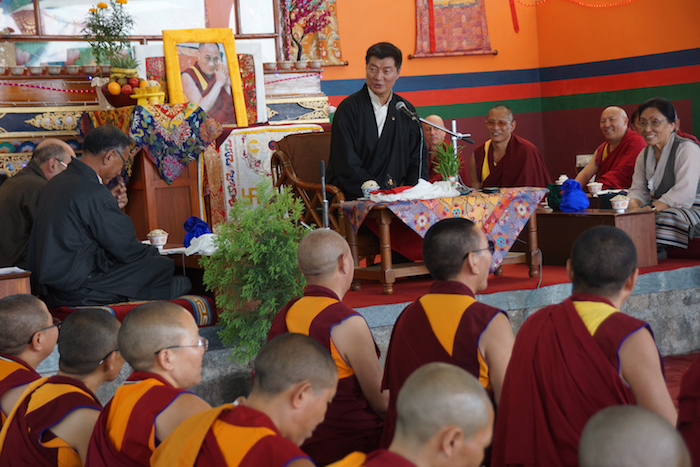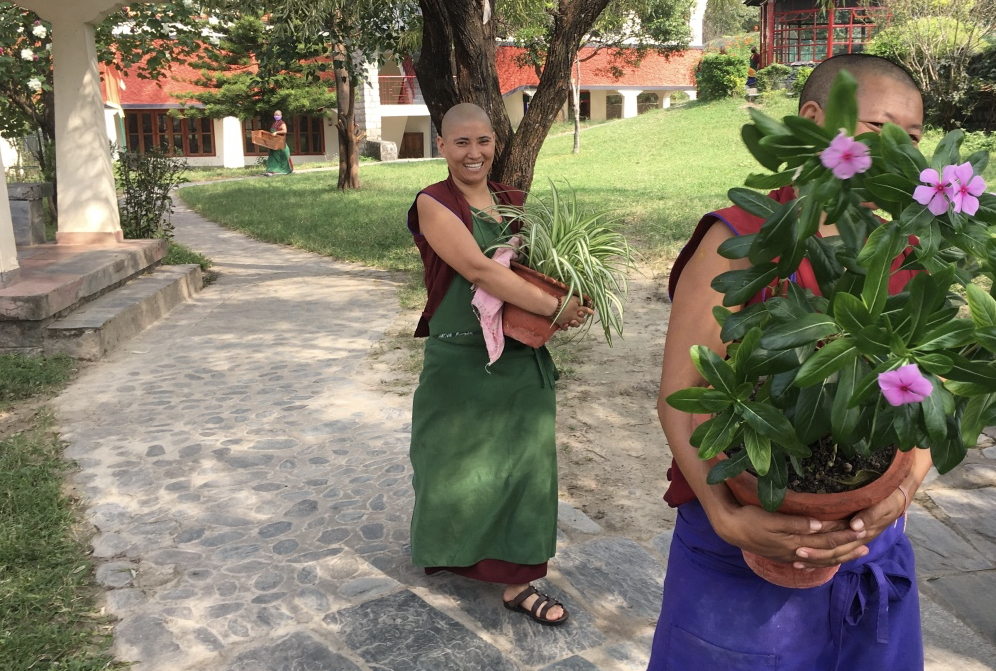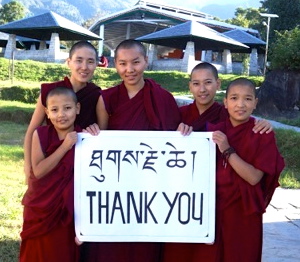To mark the 35th anniversary of the Tibetan Nuns Project in October 2022, we are re-publishing a 2001 interview with Rinchen Khando Choegyal, our Founding Director and Special Advisor. This interview was first published in our 2001 newsletter and shows how far the nuns have come thanks to your support.
Rinchen Khando Choegya is a former Minister of Education in the Tibetan Government-in-Exile and founding President of the Tibetan Women’s Association. She is married to Ngari Rinpoche, youngest brother of His Holiness the Dalai Lama. She resides in Dharamsala.

Rinchen Khando Choeygal, the Tibetan Nuns Project’s Founding Director and Special Advisor
What were your thoughts when you started the Tibetan Nuns Project?
When we started the Tibetan Nuns Project in 1987, I thought, “How best to look after the nuns?” Of course, the most important thing was to find them food, clothing, shelter and medical attention. It is, however, not enough to be fed and clothed. I knew nuns needed a better system of education, and that is what we have tried to focus on throughout the history of TNP.

An archival photo outside a tent classroom in India. Traditionally, Buddhist nuns have not had the same access to education as monks. TNP created a groundbreaking education system aimed at both preserving Tibetan culture and empowering the nuns to live and become leaders in the modern world.
Upon arriving in Dharamsala, 99% of the nuns could neither read nor write. They appeared to be strong young women, but in the classroom it was as if they were in kindergarten. Now there are nuns at both Dolma Ling and Shugsep who are beginning advanced studies. Eventually I hope that the Dolma Ling Institute for Higher Learning will be a place where both nuns and lay women can receive the finest advanced studies in all of the Tibetan Buddhist traditions.
Why is it important for nuns to be well educated?
After His Holiness came to India, he put the education of children, not just boys, on top of his priority list. So, today in the Tibetan community the young men and women are equally educated. Traditionally in Tibet there has been a very profound system of monastic education which was, however, restricted to monks. Women who decided to become nuns focused mainly on learning prayers and how to read and write Tibetan. Now that education in the lay community has become equal between men and women, I personally feel that we must restructure the nuns’ education in order to stay true to His Holiness’ vision. It is important for this vision of equality to trickle down into all parts of society.

Rinchen Khando Choegyal, director of Tibetan Nuns Project congratulating one of the Rinchen Khando Choegyal congratulates Geshemas at the historic graduation ceremony in 2016. The Geshema degree is the highest level of training in the Gelugpa tradition and is equivalent to a PhD in Tibetan Buddhism. This degree was only formally opened to women in 2012. Photo courtesy of Olivier Adam.
So the key is to educate the nuns in a system through which they can study at as high a level as they need to. Luckily, we have full support for this vision from His Holiness and from the Department of Religious and Cultural Affairs. Now the question is, what is the best way to implement this system for the nuns?
My main vision for the Tibetan Nuns Project is an education that will enable the nuns to think for themselves, to learn deeper values like: what is most meaningful at the end of your life? It will not be easy because they are not used to thinking for themselves or thinking highly of themselves.
Do the nuns receive the same education as monks?
In principle, the monks’ education is the same as the education we have implemented at our nunneries. The only difference (and this is changing at the monasteries now, too) is that a traditional monastic education teaches only Buddhist philosophy and Tibetan reading and writing. We also teach the nuns other subjects – English, history, math.
Again, we are trying to implement the vision of His Holiness, who has stressed the importance of learning these things.

Rinchen Khando Choegyal congratulates one of the 20 Geshemas in 2016. Photo by Olivier Adam
What is the role of women’s education in current Tibetan society?
Education is very, very important for any community. Women are particularly important because through them the whole community can be educated (whether they are mothers and wives or nuns teaching in the community). Also, spiritual values are precious to everyone — mothers as well as nuns. There is a terrible lack of opportunity for lay women to engage in spiritual study right now. If a lay woman is able to study, she will be able to affect her whole family. Eventually, some percentage of admission to the Institute for Higher Learning will be reserved for lay women.
Why is the Institute for Higher Learning a non-sectarian institution?
The main reason is that I feel that all the different traditions of Tibetan Buddhism boil down to the same thing, the same message from the Buddha. We are so used to belonging to one tradition or another. This can cause division as religion often does. I have the deepest respect for all traditions. I want the nuns to learn all of the traditions in order for them to get a richer education. All of the different traditions really help you in different ways to reach a high level.

A primary goal of the Tibetan Nuns Project is to help the nuns achieve more self-sufficiency through education, skill building, and income-generating projects. Here are some of the many self-sufficiency projects including tofu making, the annual calendar, prayer flags, and pujas.
Will the nuns develop “self-sufficiency”?
It is important for the Tibetan nation to be self-sufficient. The rest of the world has been very generous in supporting us in exile, but we need to try our best to attain self-sufficiency. We can’t just sit back and relax and say, “How nice, we are being supported.” We have to look at these issues: who has which skills, and how can they best work together?
The purpose of life — whether as a lay person, monk or nun — is to develop yourself as an individual and to become a useful, productive member of human society — helpful and altruistic. We have started to develop an advanced educational system for the nuns, but not all will be scholars; some nuns will need training of other kinds. All of them have something to give. I want to set up a system where they can be trained as health workers, teachers, midwives, artists, people with skills to offer the community. The nuns could even keep cows. Self-sufficiency should be stressed within each part of society, as well as within the larger society.

The nuns at Dolma Ling have now been keeping dairy cows for over 20 years as part of the nunnery’s sustainability efforts. The small herd provides milk and butter for the 261 nuns who live and study there. The dairy herd also provides manure for the nunnery’s gardens.
The basic requirements for real altruism are care and compassion. But you also need to have some skill. Not everyone can be a teacher, but everyone can develop some skills so that they can serve the community. And by doing so, the nuns will be truly living compassion. Altruism starts at home, with the person next to you. Many people care deeply about the environment, or people far away, yet don’t pay much attention to the people close to them. Even nuns can’t pray for all sentient beings and do nothing themselves. Knowing how diligent they have been at their studies, I am certain that they will be equally diligent in serving their communities when they are finished.
What do you see as the future of the Tibetan Nuns Project?
We’ve come a long way in terms of infrastructure, health, and awareness. We started Dolma Ling and Shugsep nunneries, and we also help nuns at Geden Choeling, Tilokpur and other nunneries. Over the next five years, my focus will be on the quality of the nuns’ education and administration.I want to review each and every nun and see what each nun is capable of. I want the administration to become even more efficient. But primarily Iwant to focus on the quality of the nuns’ education and to help develop them individually.
We have a long way to go in terms of fundraising. It is crucial that we build an endowment so that Dolma Ling’s operating expenses can become self-sufficient. Of course, we also need to complete the planned infrastructure of Dolma Ling, as well as build the new Shugsep Nunnery. On top of all this, we need to figure out the best way to incorporate the number of nuns arriving fresh from Tibet each year into our system.
Through the Tibetan Nuns Project, I would like to see that I look after all of the nuns in the Tibetan community. This is probably impossible! The Tibetan Nuns Project is currently helping more than 600 nuns and, at least, I want to see that this job is done correctly in terms of education and social work.
Since 1987, I have worked very hard to improve the lives of nuns. Although I have not received any external reward, it has given me great internal joy. I think through this project I have gained more than anybody in the world.

Since this interview was published in 2001, we made great progress toward our vision to educate and empower nuns of the Tibetan Buddhist tradition as teachers and leaders; and to establish, strengthen, and support educational institutions to sustain Tibetan religion and culture.
Thanks to your generosity we have:
- Created a ground-breaking educational program for nuns;
- Built and established Dolma Ling Nunnery and Institute, a non-sectarian nunnery;
- Constructed and re-established Shugsep Nunnery and Institute in India;
- Established the annual inter-nunnery debate, the Jang Gonchoe;
- Laid the groundwork for higher degrees for nuns;
- Helped award the Geshema degree for the first time in the history of Tibet;
- Started an advanced education program in Tantric Studies for the Geshema graduates
- Created a sponsorship program to support over 800 nuns and 7 nunneries in India, providing the nuns with food, education, clothing, shelter, and health care.























 In August 2015, we travelled for three days over rough, bumpy roads from Leh in Ladakh to Zanskar, a remote area in northern India. Located in this majestic, arid landscape is Dorjee Zong Nunnery, home to 19 nuns.
In August 2015, we travelled for three days over rough, bumpy roads from Leh in Ladakh to Zanskar, a remote area in northern India. Located in this majestic, arid landscape is Dorjee Zong Nunnery, home to 19 nuns.







